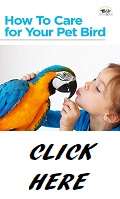Caring for Pet Birds
How to Take Care of Pet Birds
|
Reading Your Bird's Body Language
 No matter what your pet may be, understanding what your pets are telling you can be a real challenge. They ARE telling you things, but understanding what the message is can be a real challenge...even if they can speak! No matter what your pet may be, understanding what your pets are telling you can be a real challenge. They ARE telling you things, but understanding what the message is can be a real challenge...even if they can speak!
After all, even though they can "talk", few parrots, and a few other pet birds, can actually communicate their feelings and needs with words, although at least one African gray has been known to loudly announce, 'I'm bored!' when he were being neglected.
Luckily your bird's body language can speak just as loudly and as plainly as words, allowing you the opportunity to understand exactly how he is feeling.
Taking an approach of "enlightened self interest", one of the most important reasons for understanding what pet birds are thinking is that you can often avoid getting a painful bite if you know ahead of time if he is agitated or scared.
It is often easy to tell when your bird is petrified with fear. He stands up very tall and makes himself as skinny as possible. His eyes will be dilated, but he will not be moving at all.
What is happening is that he thinks that if he makes himself as skinny as possible and doesn't move, then the thing that is scaring him will overlook him.
If you reach out to pick up your bird when he is standing like this, he may suddenly break his paralysis to lash out at you in terror.
A better way to approach him at this time is to squat down until he is a bit higher than you. Then, look right at him and close your eyes for several seconds. Slowly open and close your eyes, speaking softly to him the entire time. Your bird should begin to relax.
This is because birds tend to feel more secure when they are higher than everyone else and, like cats, they consider blinking to be a sign of trust. Once your bird is relaxed, you may still want to be a bit cautious about handling him, as he may feel a bit edgy and resentful about being scared.
One clue to spotting an angry bird is that he will have extremely dilated eyes. He may weave his head back and forth, almost like a snake, and he may be vocalizing loudly. He will also be leaning slightly forward so he can attack more easily. The feathers around his neck will stick up like he is a bristling cat.
When your bird's body language says he is angry, you should let him calm down before approaching him. You can try distracting him with his favorite treat, but make sure you don't let him get close to your hands or you may get a painful bite in return for the treat.
Reading a bird's body language can be difficult, as an excited bird has the same big, dilated pupils that an angry bird has.
The excited bird may also be bobbing his head and may also have his neck feathers ruffled. If he is very excited, his whole body may be moving a bit. He will probably be quite loud and may revert to some ear piercing screams.
Even if your pet bird is just happy and excited instead of angry, his emotions are so volatile that he may still bite you unexpectedly. Wait for him to be a little less excited before handling him.
Finally, a contented bird will perch with one leg tucked up under him. He will have a relaxed posture, as if he is slouching slightly. He will groom himself right in front of you and may even stretch out a wing for a few seconds. As long as you don't make a sudden move that startles him, you won't need to worry about him lashing out.
|

